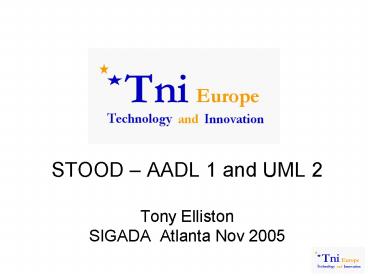STOOD - PowerPoint PPT Presentation
1 / 22
Title:
STOOD
Description:
www.ellidiss.com. STOOD. State of the Art' software modeling tool ... State of the Art approach. promotes Model Driven ... Download it: www.tni-world.com ... – PowerPoint PPT presentation
Number of Views:49
Avg rating:3.0/5.0
Title: STOOD
1
STOOD AADL 1 and UML 2Tony EllistonSIGADA
Atlanta Nov 2005
2
TNI SoftwareEllidiss TechnologiesEllidiss
Softwarewww.ellidiss.com
3
STOOD
4
AADL Architecture Analysis and Design Language
- A textual notation
- A graphical notation
- Ideal fit for critical system and software
- DO-178B ECSS-E40 MIL-STD- 498 ...
5
AADL
- Architecture Analysis Design Language
- new SAE standard
- manages System and SW components
- supports Real-Time and SW to HW binding
- may carry non functional properties
- Can be used as
- output for the System Design process
- input for the Software design process
Add such an output to System process to
formalise System specification for SW
6
Using the AADLfor critical SW development
- AADL for Real Time System Modeling
- combined HW SW descriptions
- explicit Real-Time constructs
- use language extensions for specific domains
- AADL specification as a blueprint for Software
architecture - reduce the gap between System Software
- while preserving the benefits of current
practices - and enforcing reuse of Components at high level
- AADL as a communication language throughout the
development process
7
Software Development
software requirements
SW design documentation
system specification (AADL)
source code
reusable software
SW design verification
Use the System design model as a blueprint for
SW architectural design
8
Recommendations for software methods and tools
- Model based for better flexibility
- as opposed to code based
- more semantics real-time abstractions,
multi-language, ... - formal transformations (code generation, ...)
- Component based to manage complexity
- interfaces to control interactions
- composition hierarchy to control the architecture
- avoids "spaghetti-ware"
- Strong methodological support
- naming rules, visibility rules, ...
- to encourage effort at the early stages of the
life cycle
Need for hierarchical component based method and
tool
9
STOOD 5
- AADL compliant commercial tool
- well defined step-by-step modeling process
- capture of functional and non-functional
requirements - graphical design of the architecture (UML
2.0-HOOD-AADL) - multi-language detailed design and coding (Ada,
C, C, ...) - static design verifications
- code and documentation generators
- reverse engineering (i.e. Ada -gt AADL)
- ready for industrial projects
- multi-users, configuration management,
requirements traceability - Unix-Windows interoperability
- Complies with process standards
- DO-178B, ECSS-E40, MIL-STD-498
Already in use in many large scale critical
projects (including A380)
10
STOOD 5 overview
11
AADL Model Transformations
www.tni-world.com
12
Model transformations
AADL components repository
Stood Plugins
13
Use Case 1AADL Modeler
14
Use case 1AADL Modeler
- UML 2.0 structure diagrams front end
- HOOD design rules
- visibility rules
- information hiding (i.e. for ports)
- immediate C, Ada, ... and doc generation
- AADL 1.0 generator
- AADL 1.0 semantics checker
- AADL 1.0 code generation rules
15
Use case 2"bridging the gap"
16
Use case 2"bridging the gap"
- using AADL as a System to Software bridger
- importing AADL 1.0 specifications
- to be developed with other AADL compliant tools
- preserving the System architecture
- standard Software development process
- SW architectural design refinement
- SW detailed design and documentation
- SW coding and round-trip engineering
- using the AADL output again for VV
- checking System to Software compliancy
- connecting to external Verification tools (i.e.
Cheddar) - implementing the COTRE annex
17
Use case 3reusing legacy systems
18
Use case 3Reusing legacy systems
- a three steps process
- Ada or C legacy code reverse engineering
- architecture adjustments at SW design level
- AADL generator
- benefits
- let existing source code components be made
visible for new systems at high level - building non proprietary format component
libraries - facilitating reuse of specialized building blocks
19
STOOD 5 State of the Art approach
- promotes Model Driven Engineering designing
before coding - advanced modeling solution
- model transformations
- promotes Component Based Architectures to ease
- - team development
- reuse
- testing
- maintenance
- promotes Flexible Software Design practices
- incremental documentation
- incremental coding and round-trip engineering
- incremental requirements traceability
- extensive tool customization capabilities
20
R D
- Software method projects
- STOOD is used on many projects
- Involved with Universities and colleges
- Special offers for Academia
21
QSEE-Superlite
- Integrated Meta-modeling environment
- Supports many modeling techniques
- UML, DFDs,ERDs,XML Schema models
- Syntactic and Semantic rule enforcement
- Code generation
- Ideal for academia low cost deal
22
Conclusion
- AADL 1.0 UML 2.0 compliant version of Stood 5.0
is NOW available for industrial use
- Download it
- www.tni-world.com































